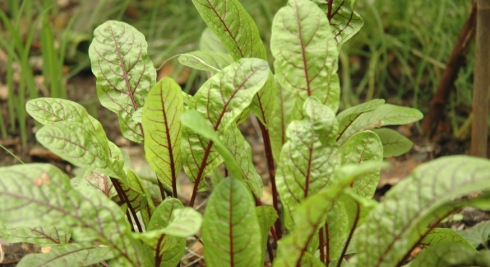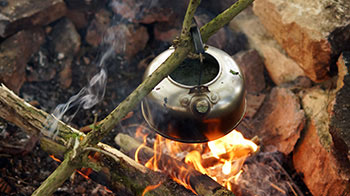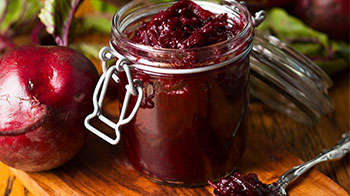You are currently browsing the category archive for the ‘vegetable’ category.
 I can see that this dish is probably mixing my culinary metaphors, but I did think this was a successful combination. I tasted my first dukkah a few years ago after I was given some as a present, and it has since become a standard in the kitchen, albeit one that gets occasional use. Dukkah (or duqqa) is an Egyptian condiment, consisting of a mix of ground nuts, seeds, spices and herbs. The jar I’m currently using contains sesame seeds, almonds, hazelnuts, coriander, cumin, salt, garlic, thyme and black pepper. I use it mostly as a coating or in this case topping, added to breadcrumbs or cornmeal. Every family would have their own blend of dukkah, so you could certainly make up your own mix!
I can see that this dish is probably mixing my culinary metaphors, but I did think this was a successful combination. I tasted my first dukkah a few years ago after I was given some as a present, and it has since become a standard in the kitchen, albeit one that gets occasional use. Dukkah (or duqqa) is an Egyptian condiment, consisting of a mix of ground nuts, seeds, spices and herbs. The jar I’m currently using contains sesame seeds, almonds, hazelnuts, coriander, cumin, salt, garlic, thyme and black pepper. I use it mostly as a coating or in this case topping, added to breadcrumbs or cornmeal. Every family would have their own blend of dukkah, so you could certainly make up your own mix!
The fine spear asparagus was delicious, although thicker spears would work well cooked a little longer. This dish would make a wonderful seasonal starter, or a main course with a big side salad and chunks of crusty bread.
Asparagus with Dukkah over Chilli Polenta
Large handful of fine spear asparagus, washed and any woody ends cut off
2 tblsp olive oil
1 tblsp dukkah
1 tblsp fine cornmeal / polenta
Dash of sea salt
1 pint water
1/4 pint polenta (I find it works well to measure the polenta as a quarter of the water!)
1 small red chilli chopped.
Pinch of salt
Preheat the oven to 180C / 350F. Put the asparagus into a roasting tin, pour over the olive oil and toss till well coated. Roast for 5 minutes.
Meanwhile heat the water in a large saucepan. As it heats, add the polenta, chilli and salt, stirring constantly with a whisk. Keep stirring until you have a thick, creamy mix, then keep warm over a very low heat (or just put the lid on the pan).
Mix the dukka and the cornmeal. Take the asparagus out of the oven, turn the spears with tongs, then sprinkle the dukkah mix over them. Put back in the oven for a further 5 minutes.
Serve on warm plates, by spooning up a heap of polenta and topping with asparagus spears.
 I’m a great believer that good gardening is easy gardening. This could be because I’m lazy and I’m certainly short of time to spend in the garden. But surely, working with nature, rather than fighting against it is best, and the plants which thrive in your garden are the ones that most belong there.
I’m a great believer that good gardening is easy gardening. This could be because I’m lazy and I’m certainly short of time to spend in the garden. But surely, working with nature, rather than fighting against it is best, and the plants which thrive in your garden are the ones that most belong there.
A few years ago, I bought a pot of red-veined sorrel at a farmers market. I transferred the plant to a bigger pot, added a few leaves to a salad every so often, then completely neglected the plant over the winter. But then the plant seeded itself in the garden, popping up in several places, and generally thriving like a weed. Not only that, but the slugs seem to leave it alone.
Now all of that seems to me like the peak of gardening success. And this sorrel has the added advantage of being an attractive plant wherever it chooses to settle.
The young sorrel leaves have a lemony, lettuce like flavour and look good in a mixed leaf salad, while older, more bitter leaves, can be cooked like spinach. Nutritionally, sorrel provide vitamin C and iron, so more than worth the (non) effort involved!
 Sadly the year in our veg garden hasn’t started too well, since we just had a couple of trees taken down and our raspberry canes and rhubarb got rather crushed in the process. Fingers crossed for a speedy recovery.
Sadly the year in our veg garden hasn’t started too well, since we just had a couple of trees taken down and our raspberry canes and rhubarb got rather crushed in the process. Fingers crossed for a speedy recovery.
But, for all of us hoping to eat some produce from our gardens (or allotments) this year, the Edible Garden Show this weekend sounds like just the inspiration needed to get us back on our feet. Now, if they could just organise plenty of sunshine for our north-facing plot….
The Edible Garden Show, Alexandra Palace, London, 20th – 22nd March 2015


